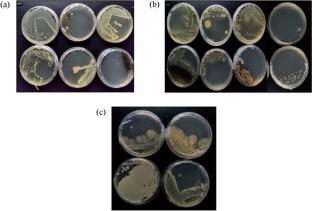Indian Journal of Microbiology ( IF 3 ) Pub Date : 2024-03-03 , DOI: 10.1007/s12088-024-01205-w Prakash Saravanan , Antara Chatterjee , K. J. Kiran , Gourav Dhar Bhowmick , Praveen Kumar Sappati , Vishwanath Nagarajan

|
Seaweed, a valuable marine resource widely cultivated worldwide, can be vulnerable to stress and microbiome alterations, resulting in the decay of seaweeds and substantial economic losses. To investigate the seaweed-microbiome interaction, our study aimed to isolate marine bacteria and fungi that can cause Ice–Ice disease and evaluate their enzymatic characteristics for potential application in bioethanol production from seaweed biomass. Three red seaweed species (Gracilaria edulis, Kappaphycus alvarezii, and Eucheuma cottonii) were obtained for our study and placed in separate culture tanks. Among the 18 isolated marine microbial species, 12 tested positive for agar and carrageenan activity: six exhibited both activities, three displayed only agar activity, and three only carrageenan activity. DNA sequencing of the positive microbes identified ten bacteria and two yeast species. The 3,5-Dinitrosalicylic acid (DNSA) assay results revealed that the identified bacterial Caldibacillus kokeshiiformis strain FJAT-47861 exhibited the highest carrageenase activity (0.76 units/ml), while the yeast Pichia fermentans strain PM79 demonstrated the highest agarase activity (0.52 units/ml). Notably, Pichia fermentans strain PM79 exhibited the highest overall agarase and carrageenase activity, averaging 0.63 units/ml. The average carrageenase activity of all six positive microbes was 1.5 times higher than their agarase activity. These findings suggest that the 12 isolated microbes hold potential for bioethanol production from macroalgae, as their agarase and carrageenase activity indicates their ability to break down seaweed cell wall carbohydrates, causing ice–ice disease. Moreover, these results provide exciting prospects for harnessing the bioconversion capabilities of these microbes, paving the way for sustainable and efficient bioethanol production from seaweed resources.
中文翻译:

探索与海藻相关的海洋微生物:可持续资源利用的生长影响和酶潜力
海藻是一种在世界范围内广泛种植的宝贵海洋资源,很容易受到压力和微生物组变化的影响,导致海藻腐烂和巨大的经济损失。为了研究海藻-微生物组的相互作用,我们的研究旨在分离可引起冰冰病的海洋细菌和真菌,并评估它们的酶特性,以用于从海藻生物质生产生物乙醇的潜在应用。我们的研究获得了三种红海藻(江蓠、卡帕藻和麒麟菜),并将其放置在单独的培养罐中。在 18 种分离的海洋微生物物种中,12 种琼脂和角叉菜胶活性检测呈阳性:6 种同时显示两种活性,3 种仅显示琼脂活性,3 种仅显示角叉菜胶活性。对阳性微生物进行 DNA 测序,鉴定出十种细菌和两种酵母菌。3,5-二硝基水杨酸(DNSA)测定结果显示,鉴定的细菌Caldibacillus kokeshiiformis菌株 FJAT-47861 表现出最高的卡拉胶酶活性(0.76 单位/ml),而酵母毕赤酵母菌株 PM79 表现出最高的琼胶酶活性(0.52 单位/ml)。 /毫升)。值得注意的是,发酵毕赤酵母菌株 PM79 表现出最高的总体琼胶酶和卡拉胶酶活性,平均为 0.63 单位/ml。所有六种阳性微生物的平均卡拉胶酶活性比其琼脂酶活性高 1.5 倍。这些发现表明,这 12 种分离的微生物具有从大型藻类生产生物乙醇的潜力,因为它们的琼脂酶和卡拉胶酶活性表明它们有能力分解海藻细胞壁碳水化合物,从而引起冰-冰病。此外,这些结果为利用这些微生物的生物转化能力提供了令人兴奋的前景,为利用海藻资源可持续、高效生产生物乙醇铺平了道路。



























 京公网安备 11010802027423号
京公网安备 11010802027423号